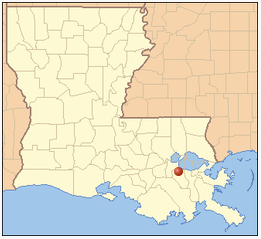| Home | Search | Emissions | Pollutants | About the Database |

Valero (26003), Norco
LDEQ Accident Report
| Accident # | 152289 |
| State Police # | 13-05012 |
| Accident Date | 2013-11-11 |
| Report Date | 2013-11-15 |
| Follow-up Date | 2013-01-10 |
| Follow-up: | Yes |
Pollutants Released
| Pollutant | Duration | Point Source | Greenhouse Gas | Criteria Pollutant | Ozone forming chemical | Amount of Release |
| NOx | 35h 34m | Flare 1 | NO | NO | YES | 113.0 pounds |
| Carbon Monoxide | 35h 34m | Flare 1 | NO | YES | NO | 617.0 pounds |
| Particulate Matter | 35h 34m | Flare 1 | NO | YES | NO | 3.7 pounds |
| Sulfur Dioxide | 35h 34m | Flare 1 | NO | YES | NO | 2,232.0 pounds |
| Hydrogen Sulfide | 35h 34m | Flare 1 | NO | NO | NO | 12.0 pounds |
| Volatile Organic Compounds (VOCs) | 35h 34m | Flare 1 | NO | NO | YES | 440.0 pounds |
Accident Classified As: Reportable Quantity
Cause of Problem: Maintenance/Procedures
On November 11, 2013, the Valero St. Charles Refinery experienced flared while making repairs on the Coker Jet Pump, which supplies water to the coke drums during the coke cutting process. Portable pumps were installed during the repairs but kept tripping due to vibration issues. Therefore, we cut feed to the coker and the heaters were put on circulation. The decreased fee into the Coker Unit from the Vacuum Unit caused the Wet Gas Compressor (WGC) to trip, which caused flaring. When the WGC tripped, pressure started to build up on the Vacuum Jet Receiver. To prevent the Vacuum Jet Receiver pump from tripping and causing a loss of vacuum in the vacuum distillation column, the backpressure on the jet receiver was relieved to the flare until the WGC stabilized. The pressure control valve on the vacuum jet receiver was open to the flare for approximately one hour, but intermittent flaring ensued until the rates in the coker unit could be increased to provide the WGC with enough gas to operate normally.
Discharge Preventable - No
Temporary pumps were installed to maintain normal operation during the necessary maintenance work of replacing the Coker Jet Pump seals. However, the temporary pumps tripped and caused the coke drums to reach their capacity. Therefore, rates were reduced to the Coker Unit, which caused the WGC to malfunction.
Notes/Remedial Actions
First written report states that emissions were minimized by reducing rates and installing a spare vacuum jet overhead pump. The incident occurred due to the inability to maintain operation of the COker WGC which pulls gases from the Coker and Vacuum Units. While the WGC was down, the Vacuum Jet Receiver was vented to the flare in order to maintain unit operation and avoid a larger flaring event associate with the unit trip. Additionally, the Flare Gas Recovery Unit remained in operation to reduce the amoin of flared gas. The event was secured by completing repairs on the coker and stabilizing the WGC. The following corrective measures were taken to prevent recurrence: 1) Review this incident with affected personnel. 2) Evaluate the piping system for use with temporary jet pumps and redesign as needed to minimize vibration issues. 3) Develop a reliability improvement plan that is based on the findings of the investigation into the jet pump failure. 4) Implement a reliability improvement plan on both in-service and spare coke cutting pumps. 5) Review the WGC operation for continued use at low rates or when the Coker is on circulation. We exceeded the reportable quantity of SO2 as a result of the incident.

Connect With Us: